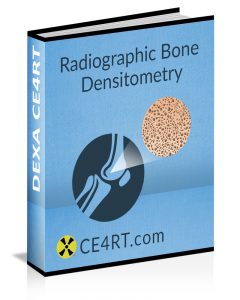DXA Osteoporosis Test: Does My Patient Need It?

Radiologic technologists see patients from all walks of life. They are in a unique position of not only providing care for the patient’s current medical problems but also offering advice on preventive medicine. When a patient comes to the radiology department, should you suggest they speak with the doctor about a screening DXA osteoporosis test? Who is at greatest risk for fractures? What are the official recommendations of the U.S. Preventive Services Task Force?
Is My Patient at Risk of Fragility Fractures?
Many bone diseases can cause fractures, but osteopenia and osteoporosis are clearly the most common causes. In both elderly men and postmenopausal women, a decrease in bone density is by far the most important risk factor that predisposes to fractures. According to a panel of experts, in Caucasian women up to 95 percent of spine and hip fractures, up to 80 percent of wrist fractures, and up to 60 percent of other fractures are the result of skeletal fragility. These figures are lower for men and for other ethnic groups. Although individuals with osteoporosis are at highest risk of fracture, those with osteopenia also have an increased risk.
The NORA (National Osteoporosis Risk Assessment) study analyzed data on bone mineral density and fractures in 200,000 females and concluded that at least 50 percent of fragility fractures occur in women who do not have osteoporosis but have low bone mass (osteopenia). So, if your patient is an older woman, her risk of osteoporosis is higher than other demographic groups and a DXA osteoporosis test may be warranted.
The USPSTF recommendation is for osteoporosis screening with DXA in women 65 years and above even without a previous history of fractures or known secondary causes of osteoporosis.
Osteoporosis Definition
To standardize the description of osteoporosis for practical purposes, the World Health Organization defines osteoporosis as a BMD (bone mineral density) that is 2.5 standard deviations or more below the average value for a young Caucasian woman with normal bones. Going by this definition, approximately 10 million American citizens over the age of 50 have osteoporosis of the hip.
The precise number of osteoporotic Americans remains unknown because data is not available for all sub-populations. In addition, different sites of the skeleton are used to measure BMD and show different degrees of bone loss. It is estimated that in addition to the 10 million Americans with osteoporosis, more than 33 million Americans have low bone mass (osteopenia) in their hip, putting them at risk of osteoporosis and its attendant complications. A DXA osteoporosis test can identify these individuals so that they can be treated appropriately.
How Prevalent is Osteoporosis?
In the year 2010, roughly 12 million Americans over the age of 50 had osteoporosis and an additional 40 million had osteopenia. By 2020, these numbers are expected to swell to 14 million and 47 million individuals, respectively. This is due to an expected increase in overall population as well as an increasing number of aging Americans. In other words, it is estimated that by the year 2020 half the American population over the age of 50 will have osteoporosis of the hip or be at risk of developing it. An even greater number will be at risk of osteoporosis at other sites in the skeleton. Radiologic technologists are in a unique position to identify these individuals with a DXA osteoporosis test.
It is not easy to estimate the true prevalence of osteoporosis because many people with the disease remain asymptomatic and undiagnosed. According to a NHANES (National Health and Nutrition Examination Survey), only 1 percent of males and 11 percent of females over the age of 65 are reported to have osteoporosis. When these individuals are measured for BMD at the hip with a DXA osteoporosis test, it is found that 4 percent of males (four times higher) and 26 percent of females (two and a half times higher) actually have osteoporosis.
Even more surprising is that 2 percent of men report a prior hip fracture but only 1 percent believe they have osteoporosis. In women, however, roughly 6 percent report a prior hip fracture and 11 percent report having osteoporosis. This data indicates that not only is the disease under-diagnosed, but that often there is a failure to recognize osteoporosis as the underlying cause of hip fractures.
Other imaging modalities such as quantitative computed tomography (QCT) are also available besides DXA osteoporosis test. Do you know its advantages and disadvantages compared to DXA?
Who is at Greatest Risk of Osteoporosis?
Men and women of different ethnicities are affected by osteoporosis to a varying degree. Men are less likely to develop osteoporosis than women. Older (postmenopausal) women are especially vulnerable. This was demonstrated by a 2002 study which revealed that women over the age of 50 constituted more than three-fourths of the total cases of hip osteoporosis (nearly 8 million in absolute numbers). So, this demographic group is an obvious choice for screening with DXA osteoporosis test.
Why Are Women at Greater Risk of Osteoporosis?
The reason women are more susceptible to the disease is because they have a lower bone mass to begin with. Also, they tend to lose bone at a faster rate during menopause. It is estimated that between the ages of 20 and 80, a Caucasian woman suffers a one-third decline in hip BMD. For Caucasian men, the comparable figure is only one-quarter. These statistics are based on a large cross-section of Americans assessed during NHANES III.
The data represents bone loss at the hip and does not necessarily represent other sites in the skeleton where the pattern of bone loss is different. For example, bone density declines in the hip in a linear pattern over the individual’s lifetime. On the other hand, bone loss at other sites in the skeleton begins in women only at the time of menopause and in men at a comparable age or older. This makes a case for DXA osteoporosis test with the hip as the preferred testing site.
At What Age Does a Woman’s Risk of Osteoporosis Increase?
Based on the WHO definition of osteoporosis, it is estimated that approximately 35 percent of postmenopausal Caucasian women have osteoporosis of the spine, hip, or wrist and are increased risk of fragility fractures. Bone mass decreases progressively over time, which is why the prevalence of osteoporosis increases with age. In other words, the percentage of population affected by osteoporosis at any given time is higher in older people. This is demonstrated by NHANES data which has shown a dramatic thirteen-fold rise in the prevalence of hip osteoporosis in Caucasian women from 4 percent in the 50-59 age group to 52 percent in the 80+ age group.
The NHANES data indicates that overall 17 percent of postmenopausal Caucasian women have osteoporosis of the hip. This group is therefore an obvious candidate for screening with DXA osteoporosis test. Comparable data from Sweden and Canada puts this number at 21 percent and 8 percent, respectively. Therefore, there is a wide variation in the prevalence of hip osteoporosis across geographical regions. The data suggests that women in Sweden have the highest risk of hip fracture due to osteoporosis and women in Canada have the least risk.
Should the DXA Osteoporosis Test Be Done Only at the Hip?
Further data needs to be collected and analyzed because NHANES only reported bone density measurements at the hip. However, based on other studies, a similar pattern of bone loss is noted at the spine and wrist. For example, the prevalence of wrist osteoporosis is 6 percent in the 50-59 age group and increases thirteen-fold to 78 percent in the 80+ age group. The overall prevalence of wrist osteoporosis in postmenopausal Caucasian women is 33 percent.
Measuring and assessing bone mass in the spine of an aging individual with a DXA osteoporosis test is relatively less accurate. This is because artifacts can mask bone loss. As mentioned, the hip and wrist exhibit a more than tenfold increase in the prevalence of osteoporosis between ages 50-59 and age 80+. However, the diagnosis of osteoporosis in the spine is only twice as much in older individuals compared to younger individuals. The overall prevalence of osteoporosis in the spine in postmenopausal women is 8 percent. In Canada, the equivalent figure is 12 percent.
Should Men Undergo Screening with DXA?
The definition of osteoporosis in older women has been well described. The definition is not as clearly explained for men. With age, men of all races lose bone mass in the hip. It would therefore be expected that the prevalence of osteoporosis in aging men is higher, similar to aging women. However, because data is very limited, a specific definition of what constitutes osteoporosis in men has not been proposed by the World Health Organization.
The cutoff value that indicates osteoporosis in women is a BMD of 0.56 grams/cm2 at the femoral neck on DXA osteoporosis test. Based on this same absolute value, NHANES III found that the prevalence of osteoporosis in men 50 years or older is 4 percent in Caucasians, 3 percent in African Americans, and 2 percent in Mexican-Americans. If comparison is made to the normal BMD value in a young healthy male, the prevalence is substantially higher at 7 percent in Caucasians, 5 percent in African Americans, and 3 percent in Mexican-Americans. In comparison, Canadian men have an overall prevalence of approximately 4 percent. The incidence of hip fractures is much lower in men than women because fewer men develop the extremely low bone density that puts a person at risk of hip fracture.
What Role Does Race Play in the Incidence of Osteoporosis?
In addition to age and gender, the prevalence of osteoporosis also varies by race. When adjusted for age, the prevalence of hip osteoporosis in African American women in the United States is 6 percent based on comparison to normal BMD values. The comparable figure for Mexican-American women is 14 percent. Postmenopausal Caucasian women have the highest prevalence of hip osteoporosis at 17 percent. This is consistent with the lower incidence of hip fractures observed in African American women.
Women of Hispanic heritage also have a lower risk of fracturing a hip compared to women with ancestry from Northern Europe. The prevalence of osteoporosis in Asians is presumed to be similar to Caucasians. Compared to Caucasian women, Japanese women have a lower prevalence of hip osteoporosis (12 percent), but a higher prevalence of lumbar spine osteoporosis. In general, it has been noted that the frequency of spine fractures is similar in Asian women and Caucasian women. However, Asian women have a considerably lower chance of suffering a hip fracture.
The key takeaway from all these numbers and statistics is that radiologic technologists should be aware of high-risk individuals based on age, gender, and race who could benefit from screening with a DXA osteoporosis test. Early diagnosis and treatment of low bone density in these individuals can prevent fragility fractures. If you enjoyed reading this article, consider purchasing our 23-credit ARRT® recognized course Radiographic Bone Density that is good for both radiography and DXA operators.
CE for DXA Technologists
This article for X-ray techs discussed the incidence of osteoporosis in different populations and the need for screening DXA tests in these individuals. To complete your requirements for ARRT® CE credits, please purchase one of our e-courses. Our California bundle includes courses that fulfill the state’s special requirements. We have similar bundles for Texas X-ray CE. Florida X-ray techs can complete their CE requirements by purchasing these courses.
